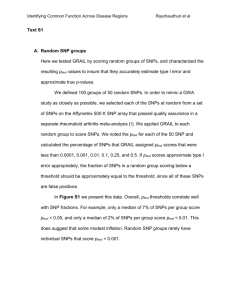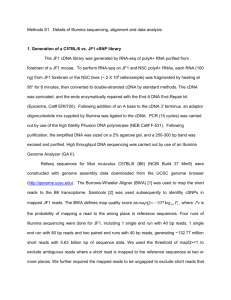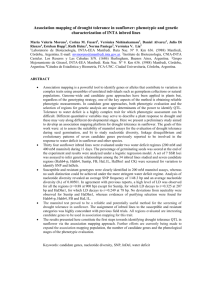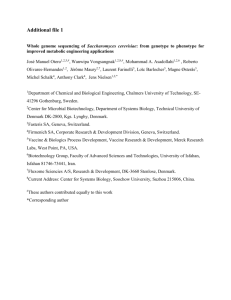mec12842-sup-0008-AppendixS1
advertisement
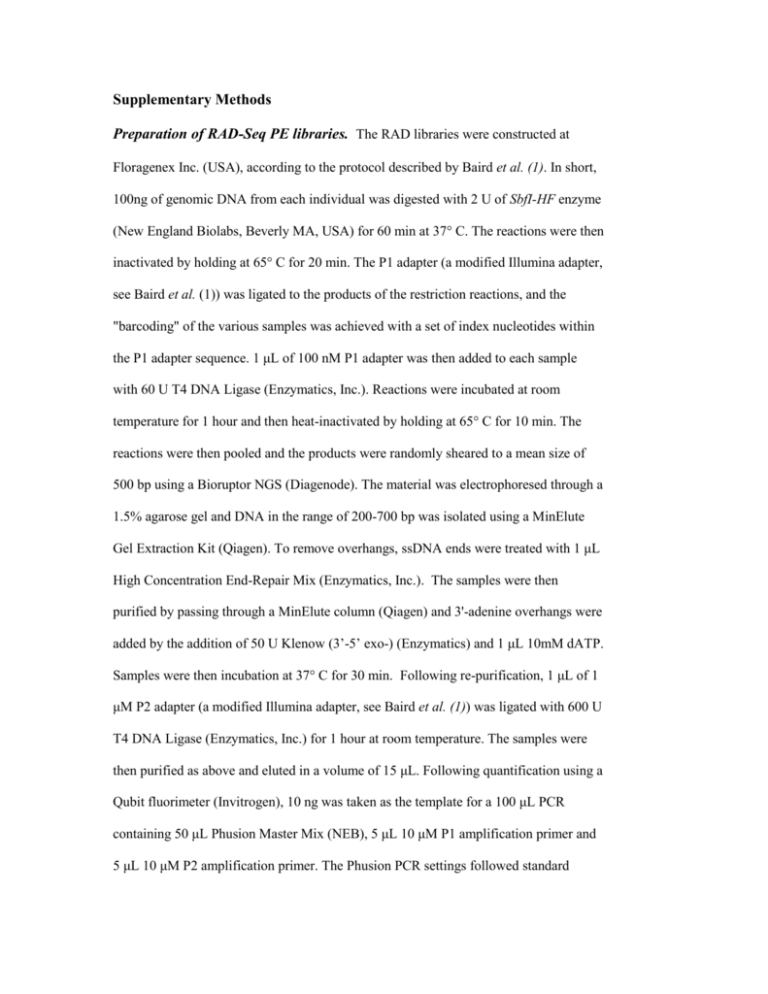
Supplementary Methods Preparation of RAD-Seq PE libraries. The RAD libraries were constructed at Floragenex Inc. (USA), according to the protocol described by Baird et al. (1). In short, 100ng of genomic DNA from each individual was digested with 2 U of SbfI-HF enzyme (New England Biolabs, Beverly MA, USA) for 60 min at 37° C. The reactions were then inactivated by holding at 65° C for 20 min. The P1 adapter (a modified Illumina adapter, see Baird et al. (1)) was ligated to the products of the restriction reactions, and the "barcoding" of the various samples was achieved with a set of index nucleotides within the P1 adapter sequence. 1 μL of 100 nM P1 adapter was then added to each sample with 60 U T4 DNA Ligase (Enzymatics, Inc.). Reactions were incubated at room temperature for 1 hour and then heat-inactivated by holding at 65° C for 10 min. The reactions were then pooled and the products were randomly sheared to a mean size of 500 bp using a Bioruptor NGS (Diagenode). The material was electrophoresed through a 1.5% agarose gel and DNA in the range of 200-700 bp was isolated using a MinElute Gel Extraction Kit (Qiagen). To remove overhangs, ssDNA ends were treated with 1 μL High Concentration End-Repair Mix (Enzymatics, Inc.). The samples were then purified by passing through a MinElute column (Qiagen) and 3'-adenine overhangs were added by the addition of 50 U Klenow (3’-5’ exo-) (Enzymatics) and 1 μL 10mM dATP. Samples were then incubation at 37° C for 30 min. Following re-purification, 1 μL of 1 μM P2 adapter (a modified Illumina adapter, see Baird et al. (1)) was ligated with 600 U T4 DNA Ligase (Enzymatics, Inc.) for 1 hour at room temperature. The samples were then purified as above and eluted in a volume of 15 μL. Following quantification using a Qubit fluorimeter (Invitrogen), 10 ng was taken as the template for a 100 μL PCR containing 50 μL Phusion Master Mix (NEB), 5 μL 10 μM P1 amplification primer and 5 μL 10 μM P2 amplification primer. The Phusion PCR settings followed standard protocols (NEB) over 18 cycles. Amplicons were then gel purified, the size range 300700 bp was excised from the gel and its DNA content adjusted to 3.6 ng/μL. Calculation of population genomic statistics. FST was estimated on a per-SNP basis, but the rest of the statistics were estimated for each contig in which a SNP was discovered. For each SNP we calculated its contribution to the sample π in each population - the probability that two randomly chosen sequences from the sample have different alleles at the SNP. For a SNP i in population x this is where the superscript s denotes “at a SNP”, ri,x and ai,x are the number of reference and alternate alleles observed in the sample from population x at SNP i. Using these values computed for two populations x and y, we calculated FST for each SNP, following Hohenlohe et al. (2), as: where m = ri,x + ai,x, n = ri,y + ai,y s all,i is the nucleotide diversity calculated when the samples from x and y are pooled together. For a contig k of length Lk having Sk SNPs in it, we estimate the nucleotide diversity in population x with: and calculate the between species sequence divergence as: and the density of fixed SNPs, df , as the number of SNPs in the contig fixed for alternate alleles in the two populations, divided by Lk. Since we used a fairly stringent criterion to call SNPs, we might not have detected all the SNPs that were present in our data. This would tend to bias nucleotide diversity downward to an unknown degree. Accordingly, we report the nucleotide diversity calculated only from those contigs that carried at least one SNP. We refer to this as the zero-truncated nucleotide diversity, and we denote it π’. To visualize patterns across the genome, average values for each statistic were calculated at closely spaced points by smoothing with a uniform kernel smoothing density (a “box” density) of width 1 Mb centered on the point (Figure 1). For parameters calculated on a per-contig basis we weighted the smoothed average by contig length using code implemented in C to be called in R. For N contigs on a chromosome, a statistic y calculated for each contig k was smoothed such that the smoothed value of y at genome coordinate zj (in base pairs) on the chromosome was where Gk is the genome coordinate at the midpoint of contig k. Smoothing values of FST proceeded similarly; however, since FST is computed on a per-SNP basis, no weights (the Lk terms) were necessary. Criteria for identification of candidate genes. Candidate migration genes were identified based upon the following criteria: (1) they were previously shown to be polymorphic in birds and were associated with migration behavior and/or circadian rhythms (3, 4) or (2) they were associated with migration-induced differences in gene expression in birds (5). Similarly, pigmentation genes included all candidates identified as potentially involved in melanin synthesis (6, 7) and carotenoid-based coloration in birds (8). Many hundreds of genes have been identified as potentially important to the neurogenetics of birdsong with varying degrees of support (9). To narrow our list of candidate genes to those with high likelihood of being linked to song behavior we restricted our analysis to genes which meet the following three criteria as described in (10): 1) evidence of differences in expression related to song exposure, 2) evidence of positive selection in the zebra finch lineage relative to the chicken, and 3) those with annotations for ion channel activity; a class of genes known to have an important role in many aspects of behavior and neurological function. To determine whether or not the inclusion of a larger subset of genes would influence our findings, we also conducted a separate analysis including all 49 genes listed in SI Table 7 of Warren et al (2010) as well as all 9 genes listed in Table 2 of Nam et al (2010) for which we had data. Literature Cited 1. Baird NA, et al. (2008) Rapid SNP Discovery and Genetic Mapping Using Sequenced RAD Markers. PLoS ONE 3(10):e3376. 2. Hohenlohe PA, et al. (2010) Population Genomics of Parallel Adaptation in Threespine Stickleback using Sequenced RAD Tags. PLoS Genet 6(2):e1000862. 3. Steinmeyer C, Mueller JC, & Kempenaers B (2009) Search for informative polymorphisms in candidate genes: clock genes and circadian behaviour in blue tits. Genetica 136(1):109-117. 4. Mueller JC, Pulido F, & Kempenaers B (2011) Identification of a gene associated with avian migratory behaviour. Proceedings. Biological sciences / The Royal Society 278(1719):2848-2856. 5. Jones S, Pfister-Genskow M, Cirelli C, & Benca RM (2008) Changes in brain gene expression during migration in the white-crowned sparrow. Brain Res. Bull. 76(5):536-544. 6. Nadeau NJ, Burke T, & Mundy NI (2007) Evolution of an avian pigmentation gene correlates with a measure of sexual selection. Proceedings. Biological sciences / The Royal Society 274(1620):1807-1813. 7. Nadeau NJ, et al. (2008) Characterization of Japanese quail yellow as a genomic deletion upstream of the avian homolog of the mammalian ASIP (agouti) gene. Genetics 178(2):777-786. 8. Walsh N, Dale J, McGraw KJ, Pointer MA, & Mundy NI (2012) Candidate genes for carotenoid coloration in vertebrates and their expression profiles in the carotenoid-containing plumage and bill of a wild bird. Proceedings. Biological sciences / The Royal Society 279(1726):58-66. 9. Scharff C & Adam I (2013) Neurogenetics of birdsong. Curr. Opin. Neurobiol. 23(1):29-36. 10. Warren WC, et al. (2010) The genome of a songbird. Nature 464(7289):757-762.








